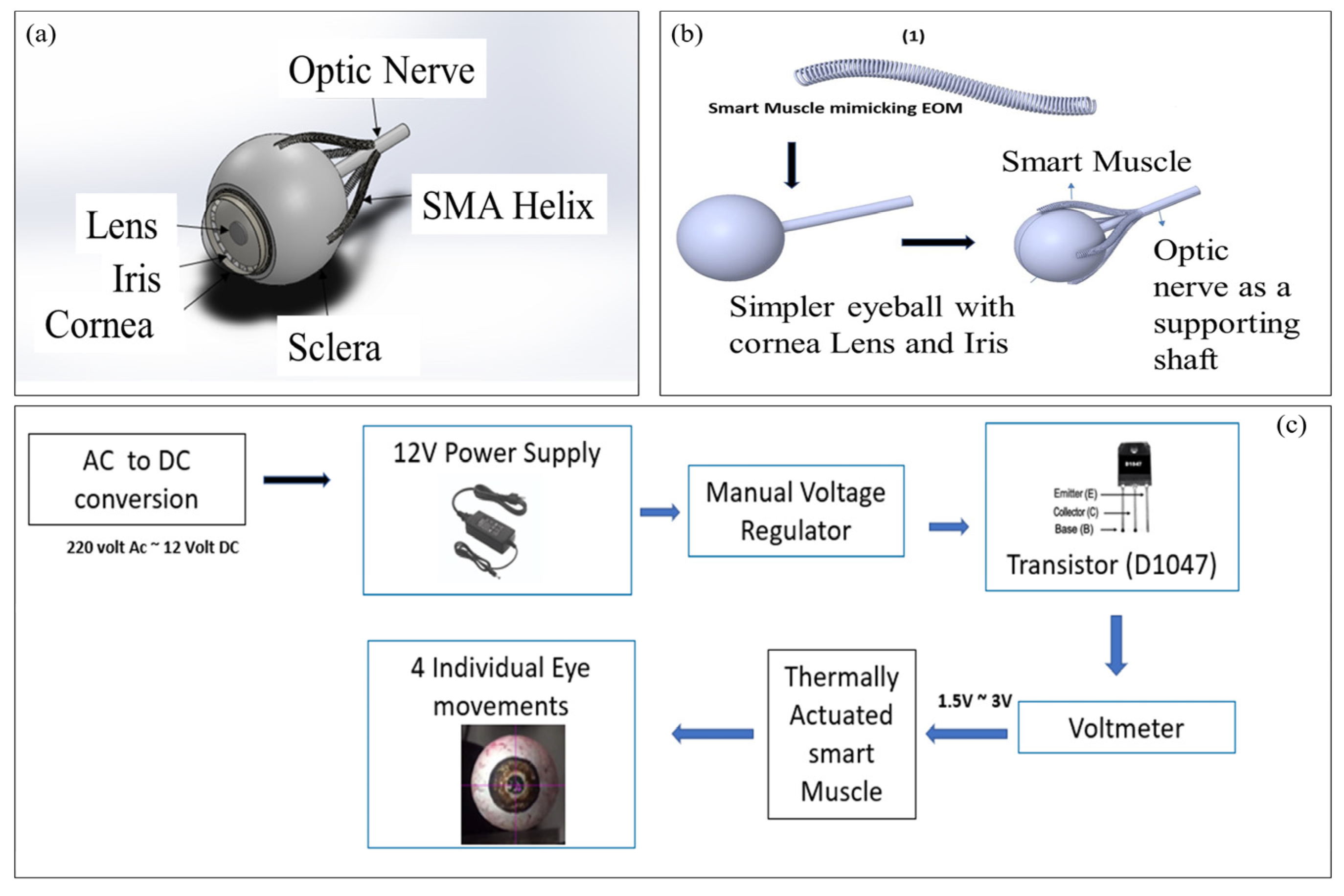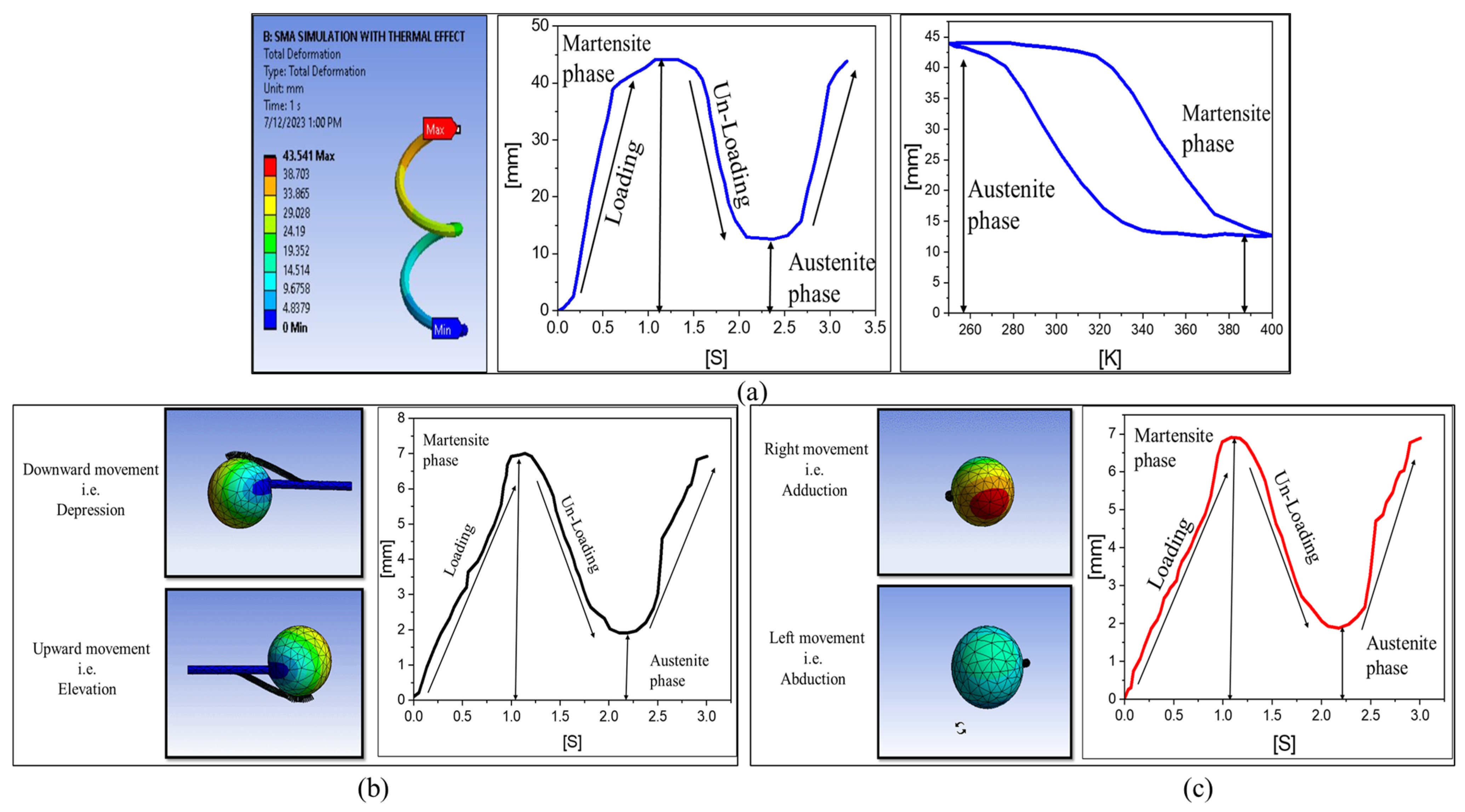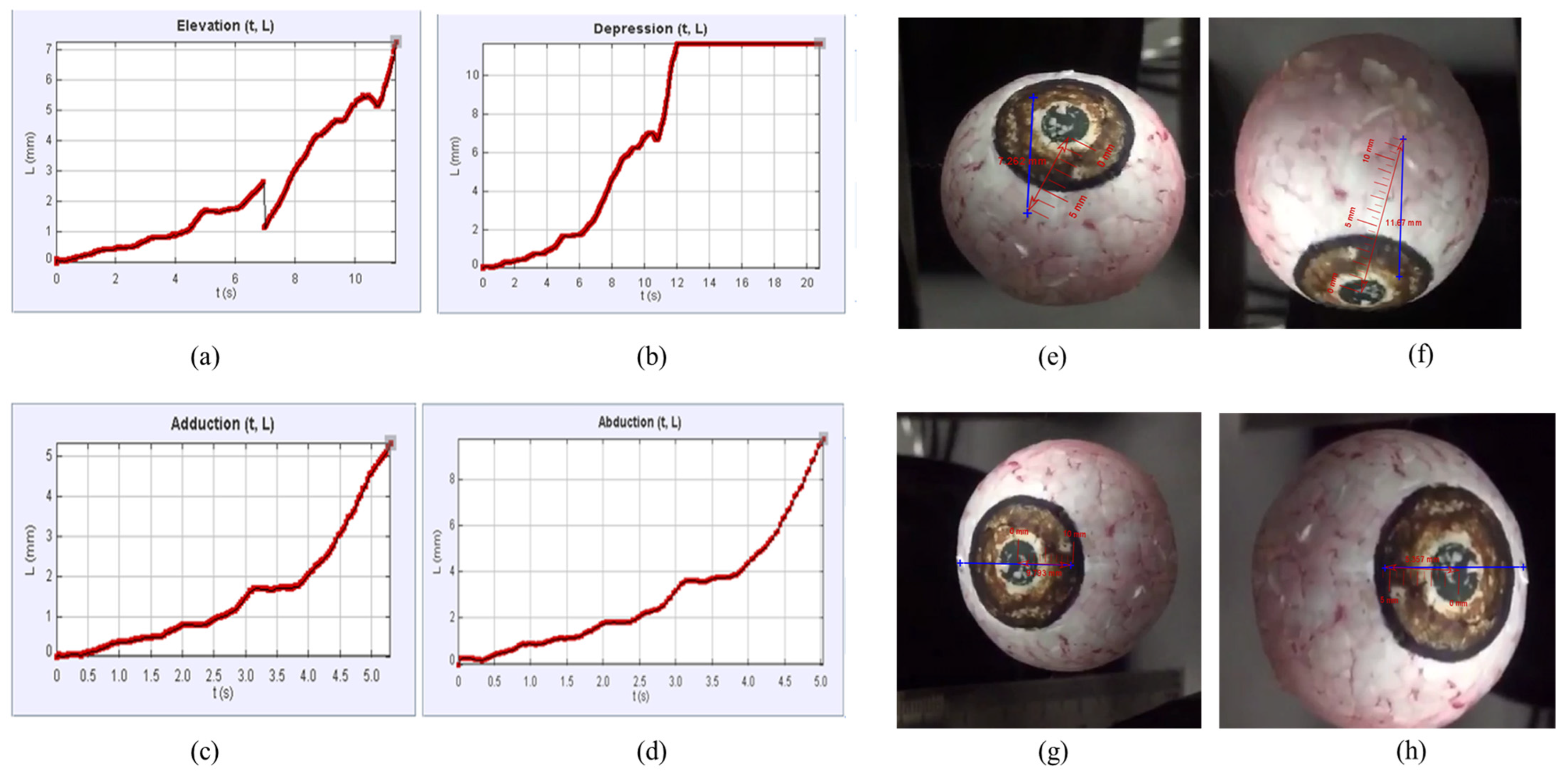Shape Memory-Based Smart Extra Ocular Muscles for Ophthalmological Studies †
Abstract
:1. Introduction
2. Methodology
2.1. Simulation and Fabrication
2.2. Prototype Testing
3. Results and Discussion
3.1. Simulation Results
3.2. Prototype Results
4. Conclusions
- i.
- Tracking graphs were acquired (distance covered over time using video analysis and modeling tool).
- ii.
- The speeds of four extraocular smart muscles (SR = 0.638 mm/s, IR = 0.957 mm/s, MR = 1.94 mm/s, LR = 1.010 mm/s).
- iii.
- Deformation of smart muscle (simulation = 6.8517 mm, prototype = 7.262 mm).
- iv.
- Motion of an eyeball (elevation/upward, depression/downward, adduction/right, abduction/left).
- v.
- Material phase characterizations were observed (martensite phase to austenite phase).
Author Contributions
Funding
Institutional Review Board Statement
Informed Consent Statement
Data Availability Statement
Conflicts of Interest
References
- Regal, S.; Troughton, J.; Djenizian, T.; Ramuz, M. Biomimetic models of the human eye, and their applications. Nanotechnology 2021, 32, 302001. [Google Scholar] [CrossRef] [PubMed]
- Bernd, P.; Jakway, J. A simplified approach to teaching medical students ocular movements and the rationale in testing the oculomotor, trochlear, and abducent nerves. Anat. Sci. Educ. 2008, 1, 126–129. [Google Scholar] [CrossRef] [PubMed]
- Gu, J.J.; Meng, M.; Cook, A.M.; Liu, P.X. Design, Sensing and Control of a Robotic Prosthetic Eye for Natural Eye Movement. Appl. Bionics Biomech. 2006, 3, 134949. [Google Scholar] [CrossRef]
- Wood, A.J.; Dayal, M.R. Using a Model to Understand the Symptoms of Ophthalmoplegia. J. Undergrad. Neurosci. Educ. 2018, 16, R33–R38. [Google Scholar] [PubMed]
- Copaci, D.-S.; Blanco, D.; Martin-Clemente, A.; Moreno, L. Flexible Shape Memory Alloy Actuators for Soft Robotics: Modelling and Control. Int. J. Adv. Robot. Syst. 2020, 17, 1729881419886747. [Google Scholar] [CrossRef]
- Bekerman, I.; Gottlieb, P.; Vaiman, M. Variations in Eyeball Diameters of the Healthy Adults. J. Ophthalmol. 2014, 2014, 503645. [Google Scholar] [CrossRef] [PubMed]
- Biometal Toki Corporation Co., Ltd. Available online: https://www.toki.co.jp/biometal/english/contents.php (accessed on 10 December 2022).
- Arghavani, J.; Auricchio, F.; Auricchio, F.; Naghdabadi, R. A Finite Strain Kinematic Hardening Constitutive Model Based on Hencky Strain: General Framework, Solution Algorithm and Application to Shape Memory Alloys. Int. J. Plast. 2011, 27, 940–961. [Google Scholar] [CrossRef]



| Characteristics | Unit | Specification |
|---|---|---|
| Coil diameter (D) | mm | 0.62 |
| Wire diameter (d) | mm | 0.15 |
| Coil diameter to wire diameter ratio D/d | - | 4.1 |
| Number of turns | mm | 6 |
| Diameter (Eyeball) | mm | 24 |
| Diameter (shaft) | mm | 3 |
| Radius (eyeball) | mm | 12 |
| Radius (shaft) | mm | 1.5 |
| Length | mm | 10 |
| Area | mm2 | 1802.461 |
| Perimeter | mm | 9.428 |
| Primary Movements | Time [s] | Length [mm] | Speed [mm/s] |
|---|---|---|---|
| Elevation | 11.380 | 7.262 | 0.638 |
| Depression | 12.180 | 11.67 | 0.957 |
| Adduction | 5.033 | 9.793 | 1.941 |
| Abduction | 5.300 | 5.357 | 1.010 |
Disclaimer/Publisher’s Note: The statements, opinions and data contained in all publications are solely those of the individual author(s) and contributor(s) and not of MDPI and/or the editor(s). MDPI and/or the editor(s) disclaim responsibility for any injury to people or property resulting from any ideas, methods, instructions or products referred to in the content. |
© 2023 by the authors. Licensee MDPI, Basel, Switzerland. This article is an open access article distributed under the terms and conditions of the Creative Commons Attribution (CC BY) license (https://creativecommons.org/licenses/by/4.0/).
Share and Cite
Ali, Z.; Gul, J.Z. Shape Memory-Based Smart Extra Ocular Muscles for Ophthalmological Studies. Eng. Proc. 2023, 45, 54. https://doi.org/10.3390/engproc2023045054
Ali Z, Gul JZ. Shape Memory-Based Smart Extra Ocular Muscles for Ophthalmological Studies. Engineering Proceedings. 2023; 45(1):54. https://doi.org/10.3390/engproc2023045054
Chicago/Turabian StyleAli, Zainab, and Jahan Zeb Gul. 2023. "Shape Memory-Based Smart Extra Ocular Muscles for Ophthalmological Studies" Engineering Proceedings 45, no. 1: 54. https://doi.org/10.3390/engproc2023045054
APA StyleAli, Z., & Gul, J. Z. (2023). Shape Memory-Based Smart Extra Ocular Muscles for Ophthalmological Studies. Engineering Proceedings, 45(1), 54. https://doi.org/10.3390/engproc2023045054






